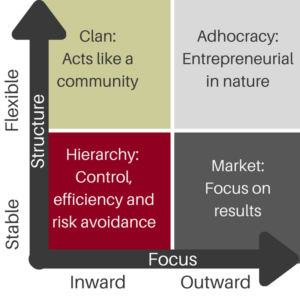Students of leadership and management are often stumped when the conversation turns to organizational culture. That’s because the concept is not clearly defined, varying from professional to professional, from organization to organization, and from industry to industry.
Nonetheless, author Michael D. Watkins says there’s little doubt that organizational culture exists, and “it plays a crucial role in shaping behavior in organizations.” His interviews with business leaders turned up many definitions, including:
- “Culture is how organizations ‘do things’.”
- “… Culture is a product of compensation.”
- “Organizational culture is the sum of the values and rituals which serve as ‘glue’ to integrate the members of the organization.”
What is Organizational Culture
Organizational culture has been defined as comprising the values and behaviors of a company’s employees. These factors can include:
- Overall tone of the shared employee experience
- Shared visions, mission statements and expectations
- Motivation and reward systems
- Views on leadership and authority relationships
- Work ethic
- Codes of conduct
- Environmental factors
- Social norms
- Risk tolerance
Such characteristics play an important role in determining whether project objectives are achieved, the PMBOK Guide notes.
How employees view their role in a project – and their function in the company as a whole – can be considered a foundational aspect of organizational culture. In turn, a company’s structure and projects can be shaped by organizational culture. Projects that are seen as aligning with organizational culture may have smoother implementation and higher success rates compared to projects that conflict with those cultural norms.
The best way to get a grasp on organizational culture is to identify the elements that go into a successful one. The Harvard Business Review identifies six components:
- Vision: A shared vision stems from a carefully crafted mission statement that answers the following three questions: Who is being served? What needs are being satisfied? How are those needs being satisfied?
- Values: Values exemplify the behaviors that are expected from employees.
- Practices: Practices explain how the vision and values are put into effect. Leadership must set an example for workers to follow.
- People: Workers need to demonstrate not just excellent capabilities and a high level of productivity, but an ability to align to the company culture and vision.
- Narrative: Organizations must share this with employees — even those who have just started — to make sure everyone understands where the company came from and where it is headed.
- Place: The physical workplace environment can have a strong impact on culture. Recent trends have leaned toward open and highly collaborative workspaces, but there has been some backlash against this thinking.Authors Kim Cameron and Robert Quinn have identified four types of organizational cultures in their groundbreaking book, Diagnosing and Changing Organizational Culture, Based on the Competing Values Framework.
The Importance of Culture
FastCompany writes that culture is what drives an organization forward, and those organizations with performance-oriented cultures see greater growth, involvement, communication and willingness to try new things. In Deloitte’s 2016 Global Human Capital Trends survey, 82 percent of respondents said culture is a potential competitive advantage. At the same time, only 28 percent of respondents said they understood their organizational culture well.
Culture is important because it:
- Reinforces (and sometimes sets) expectations, rewards and behaviors.
- Is closely related to employee engagement, which is a leading indicator of productivity and participation.
- Can predict whether mergers and acquisition will fail, because mismatched cultures create friction and resistance.
Changing the Culture
Cultural change needs to start at the top of the organization, with leaders setting a good example and displaying the behaviors they expect from managers and workers. From that point, organizations can do the following:
- Get input: Culture is best designed with cooperation. Organizations should bring in stakeholders from throughout the organization — from the C-suite to the front line — to provide perspective and describe the type of business they want to work for.
- Create a roadmap: Once the organization knows where it’s going, it needs to determine how to get there. That involves creating a strategic plan with clear objectives and milestones. No one should expect change to happen overnight.
- Explain outcomes and benefits: This involves rewarding behavior that aligns with the culture.
- Measure the results: It’s not enough to have a sense that things are moving in the right direction. Organizations should get hard data to assess what is working and what is not. Employee feedback surveys, administered by the human resources function, can help perform spot-checks and identify potential weaknesses.
